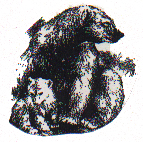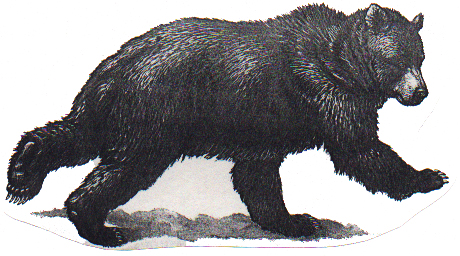 Marshall
Cultural Atlas Marshall
Cultural Atlas
This collection of student work is from
Frank Keim's classes. He has wanted to share these works for others
to use as an example of Culturally-based curriculum and documentation. These
documents have been OCR-scanned. These are available
for educational use only.
Flora Evan
Hibernation and Denning Of Grizzly
Bears
This research paper explains the hibernation and denning habits of
the Grizzly bear. I will talk about the bear's temperature and heart
rate during hibernation, how long they stay in the den and how they
can hibernate that long without eating or drinking anything.
The Grizzly bear has a heavy body with relatively short legs, neck
and tail. It has a large head with rounded ears and unusually small
eyes for such a large animal. It has a heavy coat, padded by several
inches of fat which creates the illusion of a slow and clumsy animal.
But, this is not the case. A Grizzly bear can reach a speed of 35 or
40 mph for short distances. This is fast enough to catch a running
horse and kill it with a blow of its forepaw. Most bears can only
leap a few feet off the ground. Some bears are good climbers, and all
are capable swimmers.
The color of Grizzly bears throughout Alaska differs widely from
area to area. Some Grizzlies are black with silver-tipped hairs and
some have pale blond or yellow hair. Most Grizzlies are a shade of
brown or gray-brown. Bears that have blond bodies and dark legs are
more common. Male Grizzlies tend to be darker than females. Cubs
usually have a white color that lasts through the first summer. There
is only one other bear that can be mistaken for a Grizzly bear, and
it is the Black bear.
Adult Grizzly bears are huge, but do differ in size,depending on
their
Age, sex, time of year and geographic location. Coastal Grizzlies
are reported to be larger than interior Grizzlies. Interior Grizzlies
are about one-third smaller than Coastal Grizzlies. Females in the
same area normally weigh about half as much as the male. Grizzlies
weigh about 20 to 30% more in the fall before going into hibernation.
A coastal Grizzly may grow to be eight or nine feet and stand more
than four feet at the shoulders and weighing up to 1,500 pounds.
Interior Grizzlies are much smaller.
The skull of a bear from the coastal area reaches 98% of its
length by the age of 10 years and 98% of its width by the age of 12
years. Skull sizes of the Grizzlies are the largest and widest from
the Kodiak island area and the Alaska Peninsula.
The hearing and smelling of a Grizzly is far better than its
eyesight. The Grizzly bear has difficulty defining man when standing
still. Grizzly bears are normally shy except when hungry, disturbed
or attacked by something. Nothing can challenge a bear except a man's
rifle.
The Grizzly bear hibernates every year. A Grizzly bear's instinct
to den is an adaptation to life in places where conditions might
otherwise threaten survival. There has been an argument between
scientists as to whether bears are true hibernators. When it
hibernates the Grizzly has a body temperature of less than 10 degrees
Fahrenheit and its hear rate is eight beats per minute. Normally,
before entering the den it is 40 beats per minute.
The Grizzly bear does not eat, drink, defecate or urinate during
its
entire hibernation period which can be up to six months or longer.
It produces metabolic water from fat and doesn't produce products
that cause it to urinate. Considering the evidence from Grizzly and
rodent studies, Grizzlies are better hibernators in a functional
sense.
The Grizzly may spend from two to seven months at the den sites or
in the dens. It stays in its den during the winter because of the
decreased food supply in winter. Grizzly dens are usually found in
high snow accumulation areas on mountain slopes. The hibernation
period is usually from October to April. Before hibernating, the bear
may dig out its den long before it retires to it. Most bear dens are
three feet wide at the entrance, five feet long, four feet wide and
four feet high. The bears don't usually use the same den twice. They
look for den sites where roots of trees can support the den, or in a
low cave, a hollow tree or in the shelter of a brush pile. Sometimes
an earthen den is dug directly into the ground. The bears work on
their den sites just as birds work at building their nests. Bears
seem to learn by experience. Older Grizzlies are likely to choose
more suitable sites, and the younger bears choose dens that aren't as
suitable as those of experienced bears'. Grass, moss and evergreen
boughs are carried inside to line the den.
Denning time generally coincides with the first signs of winter
weather. During late summer, Grizzly bears have been known to eat
20,000 calories a day to reserve fat for hibernation. This is like a
human being eating 38 banana splits or 42 hamburgers each day. As a
result, Grizzlies weigh 20-30% more before going into hibernation
than when they come out in the spring.
The first Grizzly to go into its den is a pregnant female. The
pregnancy is perfectly timed with the period of hibernation. After a
period of time, snow piles over the entrance of the den and
obliterates all traces of the bear. The den of the hibernating
Grizzly is almost like a tomb if you ever get a chance to look
inside. And when the bear is in hibernation, it hardly looks like a
living mammal. But, there is indeed life in the den. And a second
little life is growing during hibernation in the pregnant female. If
this is her first pregnancy she will probably have one cub, but if it
is her second or third pregnancy she will probably have two or three
cubs.
In summation, the Grizzly bear is a fascinating animal with an
amazing ability to adapt to many different climates and topographies.
One characteristic which allows it to survive throughout its range is
its instinct to hibernate. Hibernation allows it to conserve its
energy during the harshest season, winter, and to emerge in good
health for another year in the wild.
 
BIBLIOGRAPHY
BLEDSOE, T. Brown Bear Summer. 1987.
MURIE, A. The Grizzlies of Mount McKinley. 1981.
HERRERO, S. Bear Attacks. 1985.
REARDEN, J. Alaska Mammals. 1981.
DOMICO and NEWMAN. Bears of the World. 1988.


Bear Fire
Stories and Poems
about Bears
|
by Marshall High School
Language Arts Classes
Spring, 1992
Produced
by
Information
about Bears
Creative
Stories from the Imagination
True
Stories from Experience
Poems
Christmastime Tales
Stories real and imaginary about Christmas, Slavik, and the New Year
Winter, 1996 |
Christmastime Tales II
Stories about Christmas, Slavik, and the New Year
Winter, 1998 |
Christmastime Tales III
Stories about Christmas, Slavik, and the New Year
Winter, 2000 |
| Summer Time Tails 1992 |
Summertime Tails II 1993 |
Summertime Tails III |
| Summertime Tails IV Fall, 1995 |
Summertime Tails V Fall, 1996 |
Summertime Tails VI Fall, 1997 |
| Summertime Tails VII Fall, 1999 |
Signs of the Times November 1996 |
Creative Stories From Creative Imaginations |
| Mustang Mind Manglers - Stories of the Far Out,
the Frightening and the Fantastic 1993 |
Yupik Gourmet - A Book of
Recipes |
|
| M&M Monthly |
|
|
| Happy Moose Hunting! September Edition 1997 |
Happy Easter! March/April 1998 |
Merry Christmas December Edition 1997 |
| Happy Valentine’s
Day! February Edition
1998 |
Happy Easter! March/April Edition 2000 |
Happy Thanksgiving Nov. Edition, 1997 |
| Happy Halloween October 1997 Edition |
Edible and Useful Plants of Scammon
Bay |
Edible Plants of Hooper Bay 1981 |
| The Flowers of Scammon Bay Alaska |
Poems of Hooper Bay |
Scammon Bay (Upward Bound Students) |
| Family Trees and the Buzzy Lord |
It takes a Village - A guide for parents May 1997 |
People in Our Community |
| Buildings and Personalities of
Marshall |
Marshall Village PROFILE |
Qigeckalleq Pellullermeng ‘A
Glimpse of the Past’ |
| Raven’s
Stories Spring 1995 |
Bird Stories from Scammon Bay |
The Sea Around Us |
| Ellamyua - The Great Weather - Stories about the
Weather Spring 1996 |
Moose Fire - Stories and Poems about Moose November,
1998 |
Bears Bees and Bald Eagles Winter 1992-1993 |
| Fish Fire and Water - Stories about fish, global warming
and the future November, 1997 |
Wolf Fire - Stories and Poems about Wolves |
Bear Fire - Stories and Poems about Bears Spring,
1992 |
|